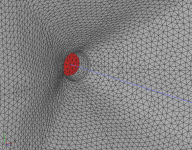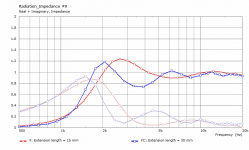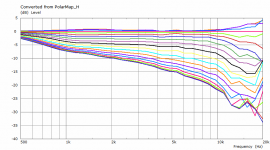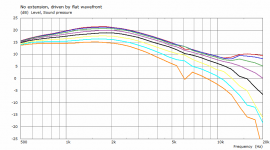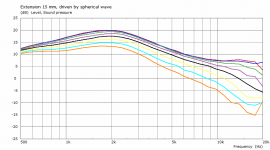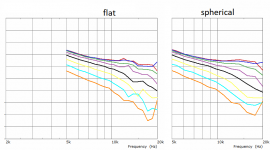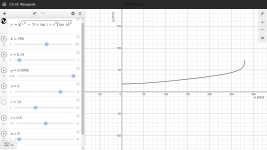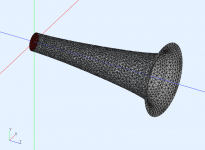The throat extension again - I tried one half long as the previous one:
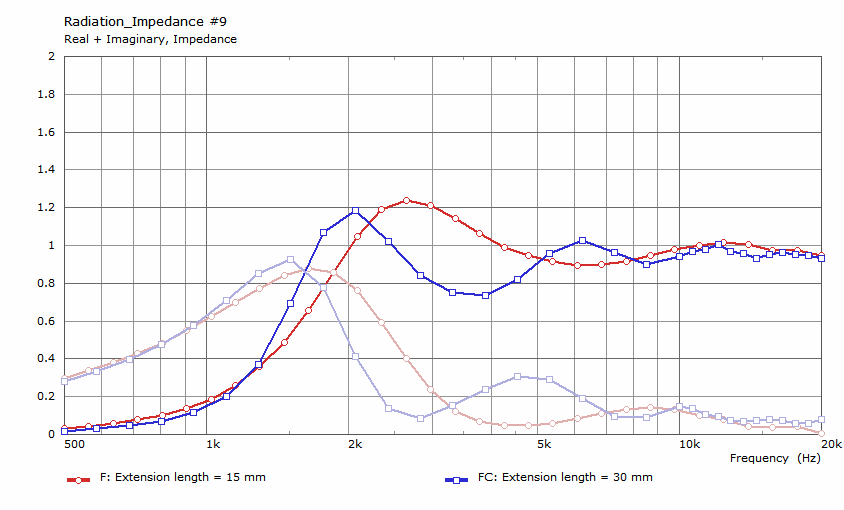
Attachments
Last edited:
Hmm, I would not expect such rise from the polars, but looking again, I suppose it could be correct. But is it really? As the power response corresponds to a polar at about 45 deg off-axis, could be.
45 off axis at 5K is about -9dB in ABEC and the power curve is -9.4dB in Vituix so I would say it is right and follows the rule of thumb closely enough.
I was aiming for a smooth but rising DI in that one, perhaps steeper than intended.
Interesting is a comparison of radiation patterns above ~8 kHz. Conical extension could have a slight advantage in the highest octave, if driven by a proper wavefront, it seems (which is easier to do with a smaller driving diameter I suppose).
a) 36 mm OS throat driven by flat wavefront, zero throat angle, no throat extension:
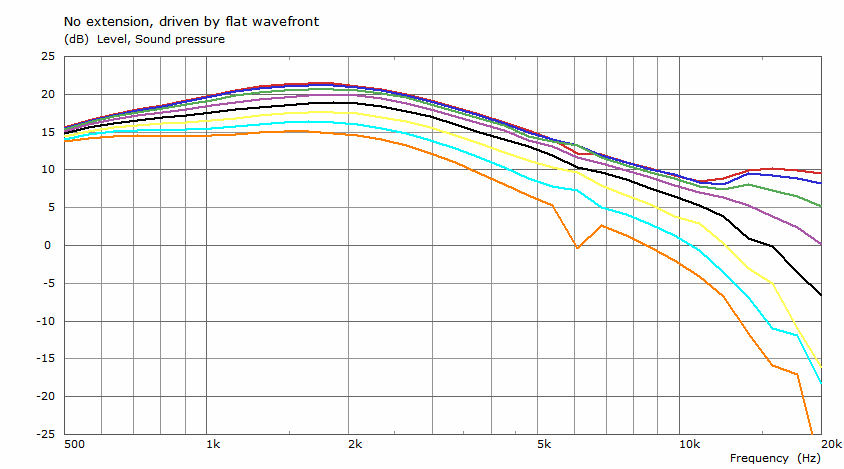
b) 36 mm throat extended by a conical segment 15 mm long, 27° throat angle, driven by a matched spherical wavefront:
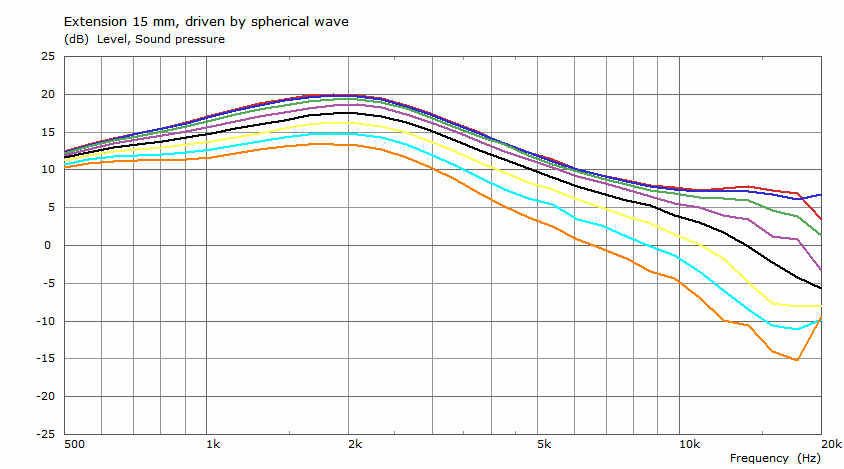
a) 36 mm OS throat driven by flat wavefront, zero throat angle, no throat extension:
b) 36 mm throat extended by a conical segment 15 mm long, 27° throat angle, driven by a matched spherical wavefront:
Attachments
David, could it be that Voishvillo's interest and research is partly related to (compression) drivers with annular...
His interest in annular compression drivers wouldn't alter the relative importance of distortion, as far as I can see.
But I haven't read many of the convention papers, my library only has the Journal lately.
..Then I started to study the perception of nonlinearity and found, much to my surprise, that they really weren't very audible. Alex became quite interested in our work and, as I said, told me that he had duplicated it at JBL...
Many of those papers are old...
These papers are all new(ish) published after the JBL research you mention.
The first two are both 2019 for instance, I didn't include any from before the JBL study.
But I still remain cautious about the "nonlinearity of breakup modes"...I suppose that it's possible, just does not seem likely.
Yes, seems unlikely to me too.
Best wishes
David
I meant to get back to this earlier.
Alex specialty is in nonlinear acoustics. When we first met I too was doing a lot of nonlinear work as well. At that time we both believed that nonlinearity was a major aspect of sound design.
Then I started to study the perception of nonlinearity and found, much to my surprise, that they really weren't very audible. Alex became quite interested in our work and, as I said, told me that he had duplicated it at JBL. He admitted to duplicating our results.
Why it now appears that he has changed his mind, I can't explain, other than to say that maybe he hasn't - I have not talked with him for a long time. Many of those papers are old, back when even I myself believed in the high audibility of nonlinear distortion.
As someone who's worked in engineering for nearly two decades, I can't even count the number of times I've worked on a paper or a project that seemed pointless. It's just part of the job 🙂
Sometimes a client or management wants you to research something, and even though you think it's a dead-end, they're the ones that call the shots, not me.
And just to clarify, my intention isn't to disparage management. I'm just saying that we don't always agree on what's important.
For instance, two of my biggest flubs of all time:
1) When colleagues of mine were beginning to use the World Wide Web, I thought it was stupid. As I saw it, bulletin board systems and Usenet were perfectly good for sharing information, and I didn't see any real appeal to the World Wide Web. It seemed unnecessary.
2) When I was working on the early smart phones, it ENRAGED me that Ericsson wanted to put cameras in them. I sat in meetings where they proposed the idea and I was LIVID. To me, it seemed like taking photos with a potato. Digital cameras of the era were already WAY WORSE than film, and camera phones were worse than that. If I could have waved a magic wand and eliminated the entire idea of a "camera phone", I would have.
Last edited:
One thing that strikes me as odd is that the JBL "perception" gurus, Toole and Olive, both consider nonlinearity to be insignificant. And yet, they (JBL/Harman) publish papers expounding on the distortion reduction. This sound to me like marketing campaigning for inclusion of performance enhancements that perhaps the author doesn't really buy into.
Floyd once alluded to me that he had problems with the way marketing wanted to "sell" products based on metrics that weren't really significant i.e. THD. To marketing all that matters was what the buyers thought were important, not what Floyd did.
Floyd once alluded to me that he had problems with the way marketing wanted to "sell" products based on metrics that weren't really significant i.e. THD. To marketing all that matters was what the buyers thought were important, not what Floyd did.
Exactly!
For instance, back during the Dot Com Bust, I worked for a company that sold space in their data center. Customers were *obsessed* with all kinds of weird minutiae:
* redundant connectivity
* redundant power
* high security
In a nutshell, the customer was completely fixated on concerns about what would happen if there was a local power outage, or what would happen if our connection to the Internet went down.
The question NOBODY asked was, "What happens to our servers if you guys run out of money?"
Naturally, we ran out of money, and a lot of companies got knocked off the Internet.
Sometimes customers don't ask the right questions, or value things which aren't all that important.
For instance, back during the Dot Com Bust, I worked for a company that sold space in their data center. Customers were *obsessed* with all kinds of weird minutiae:
* redundant connectivity
* redundant power
* high security
In a nutshell, the customer was completely fixated on concerns about what would happen if there was a local power outage, or what would happen if our connection to the Internet went down.
The question NOBODY asked was, "What happens to our servers if you guys run out of money?"
Naturally, we ran out of money, and a lot of companies got knocked off the Internet.
Sometimes customers don't ask the right questions, or value things which aren't all that important.
Hey PB - Don't feel bad about the camera phone. I thought that email on your phone was dumb. Guess I was wrong.
It was later pointed out to me that hall of fame sluggers strike out more than half the time. Using that criteria my engineering career has been brilliant ;-)
It was later pointed out to me that hall of fame sluggers strike out more than half the time. Using that criteria my engineering career has been brilliant ;-)
mabat, if it is not asking too much I would be interested to see the throat impedance of a 18x18° horn with a continuous curve (Dimensions: 180 mm H x 180 mm W x 280 mm D).
I realize that such a horn resembles a PWT.
I realize that such a horn resembles a PWT.
One thing that strikes me as odd is that...(JBL/Harman) publish papers....for inclusion of performance enhancements that perhaps the author doesn't really buy into...
The sales people will, of course, emphasise what they think the customer is interested in.
But it seems that the papers do reflect the internal research priorities at JBL.
For instance the low distortion drivers are not really marketed as such, just used anonymously inside finished systems.
And the published papers are not promoted either, no publicity on the website or "white papers".
Not even in the Journal of the AES, just a presentation to a limited audience at one convention.
(I wish they did promote them with reprints, some I haven't even been able to find myself because my library has limited Convention access.)
So it looks like there is still interest in distortion reduction at JBL.
If the result is that the problem is more or less "solved" for domestic systems then that's fine.
Best wishes
David
Please specify the exact shape as "continuous curve" is a very broad term: OS-SE Waveguidemabat, if it is not asking too much I would be interested to see the throat impedance of a 18x18° horn with a continuous curve (Dimensions: 180 mm H x 180 mm W x 280 mm D).
I realize that such a horn resembles a PWT.
One thing that strikes me as odd is that the JBL "perception" gurus, Toole and Olive, both consider nonlinearity to be insignificant. And yet, they (JBL/Harman) publish papers expounding on the distortion reduction. This sound to me like marketing campaigning for inclusion of performance enhancements that perhaps the author doesn't really buy into.
Floyd once alluded to me that he had problems with the way marketing wanted to "sell" products based on metrics that weren't really significant i.e. THD. To marketing all that matters was what the buyers thought were important, not what Floyd did.
Humanity might not be ready to ignore distorsion just yet. Certainly not audio heads. Still it's a linearity deficiency. If you could reduce them with a snap of a finger - would you still not bother?
//
And then you get people like amirm at Audio Science Review, writing about his particularly high acuity to distortion. Based on DBT tests.
Could it be one of those factors that varies more between individuals....
Could it be one of those factors that varies more between individuals....
We can hypothesize about all kinds of things, but the fact remains, Amir's claims aside, that there is no published data to support a claim that people hear differently. In fact JBL's data that normal people judge perception that same as experts in a large blind trial controverts this idea.
Regarding distortion, I lean towards Dr. Geddes' findings.
However, in my experience, distortion cannot be ignored once a driver is pushed towards its limits.
No so much wrt SPL - which is hardly ever a concern at home - but primarily as regards the lower usable limit.
Very few 1" drivers allow a low crossover point without sounding rough, strained etc.
@mabat: I'll check the link and let you know.
However, in my experience, distortion cannot be ignored once a driver is pushed towards its limits.
No so much wrt SPL - which is hardly ever a concern at home - but primarily as regards the lower usable limit.
Very few 1" drivers allow a low crossover point without sounding rough, strained etc.
@mabat: I'll check the link and let you know.
However, in my experience, distortion cannot be ignored once a driver is pushed towards its limits.
I've always said that one must consider the power handling of the source. By this I don't mean the power that it takes to damage or burn out the unit, but the power level at which the distortion becomes unacceptable (which is usually well below the melt-down point.) ALL transducers have this limit, but it is virtually never disclosed by the manufacturers and I often see people use the "power rating" as an indication of it's SPL capability and this just isn't the case at all. One must keep below this level, in which case distortion is not an issue - by definition.
It's the idea that 20% THD sounds better than 10% THD that I object to, because this is too is hardly ever the case.
It's the idea that 20% THD sounds better than 10% THD that I object to, because this is too is hardly ever the case.
Ooops! Said that backwards - my bad!
There is no data, to my knowledge, that indicates even or odd order are more or less audible. Our data did not find such a relationship.
In later unpublished studies, I did find that the "higher order moments" like the kurtosis and skew of the signal, had an effect, but that does not equate to even and odd orders.
Last edited:
Simulated in an infinite baffle, as usual.mabat, 'request' profile attached.
Attachments
Last edited:
- Home
- Loudspeakers
- Multi-Way
- Acoustic Horn Design – The Easy Way (Ath4)
